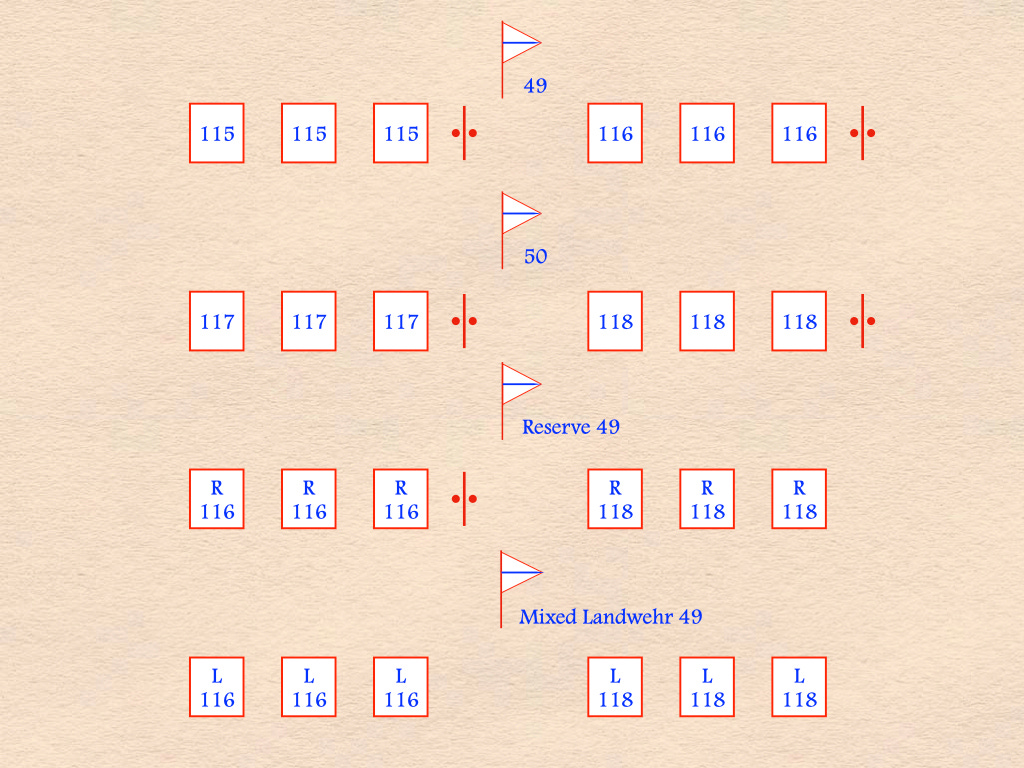The five peacetime infantry regiments from Hesse-Darmstadt formed a pair of peacetime infantry brigades, one of the normal two-regiment type and one of three regiments. So organized, they provided the infantry component of a peacetime infantry division in which the cavalry and field artillery regiments also bore titles that tied them to the Grand Duchy.
Peacetime Regiments of the Grand Duchy of Hesse-DarmstadtInfantry Life Guard Infantry Regiment (1st Grand Ducal Hessian) Nr. 115
Infantry Regiment Kaiser Wilhelm (2nd Grand Ducal Hessian) Nr. 116
Infantry Life Guard Regiment Grand Duchess (3rd Grand Ducal Hessian) Nr. 117
Infantry Regiment Prince Carl (4nd Grand Ducal Hessian) Nr. 118
The 5th Grand Ducal Hessian Infantry Regiment Nr. 168
Guard Dragoon Regiment (1. Grand Ducal Hessian) Nr. 23
Life Guard Dragoon Regiment (2. Grand Ducal Hessian) Nr. 24
1st Grand Ducal Hessian Field Artillery Regiment Nr. 25
2nd Grand Ducal Hessian Field Artillery Regiment Nr. 61
At the start of the war, Hesse-Darmstadt mobilized a total of nine infantry regiments: five active regiments, two Reserve regiments, and two Landwehr regiments. Of these, all but one were paired off to form brigades with exclusive connections to the Grand Duchy.
The one infantry regiment that found itself serving with a ‘foreign’ brigade in August of 1914 was the 168th Infantry Regiment [5. Großherzoglich-Hessisches Infanterie-Regiment Nr. 168]. In peacetime, it had served as the third regiment of the 49th Infantry Brigade. Upon mobilization, it met the typical fate of the supernumerary infantry regiments of the peace establishment. That is, it reported for duty with a reserve infantry brigade.
Hesse-Darmstadt formed its second-line infantry units “by the book.” That is, for each of its two peacetime infantry brigades, it formed a Reserve infantry regiment, a Landwehr infantry regiment, and a brigade Ersatz battalion. Indeed, the only discrepancy between the ideal mobilization of second-line infantry units and the units of that class produced by Hesse-Darmstadt was the absence of a machine gun company in the 118th Reserve Infantry Regiment.
As one of the peacetime infantry brigades of the Grand Duchy had consisted of three (rather than the usual two) infantry regiments, it is quite possible that the brigade Ersatz battalion that it formed [Brigade Ersatz Bataillon 49] possessed six (rather than the usual four) companies. That said, it is also possible that the extra infantry regiment of the 49th Infantry Brigade was exempted from the requirement to contribute two companies to a brigade Ersatz battalion.
Between 1897 and 1913, the 168th Infantry Regiment had been a two-battalion unit. Thus, it had produced far fewer reservists than a normal three-battalion regiment. However, upon mobilization, it was nonetheless obliged to fill out three active battalions. This, in turn, reduced the number of trained reservists available for service with a Reserve infantry regiment, a Landwehr infantry regiment, or a brigade Ersatz battalion.
Sources: This post is based on data gleaned from the organizational appendix to the first volume of the German official history; Hermann Cron (C.F. Colton, translator) Imperial German Army: Organization, Structure, Orders-of-Battle (Solihull: Helion, 2002); Löbell's Jahresberichte über das Heer-und Kriegswesen [Löbell’s Military Matters and Warfare Annual], 1913, pages 12 and 13; and Eike Mohr, Heeres- und Truppengeschichte des Deutschen Reiches und seiner Länder 1806 bis 1918 (Osnabrück: Biblioverlag, 1989) page 777.






